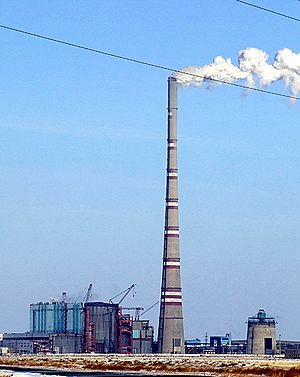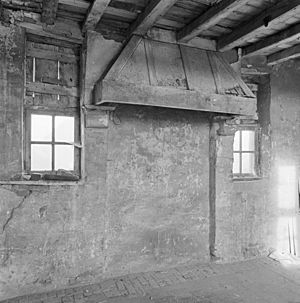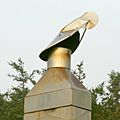Chimney facts for kids

A chimney is a tall structure. It helps hot smoke and gases escape from things like fireplaces, stoves, and furnaces. This smoke goes safely into the air outside. Most chimneys stand straight up. This helps the hot gases rise easily. It also pulls fresh air into the fire, which helps it burn better. This is called the "stack effect." The space inside a chimney is called a flue. You can find chimneys on buildings, old steam trains, and ships. In some places, like the United States, tall chimneys on trains or ships are called "smokestacks" or "funnels."
The height of a chimney is very important. Taller chimneys help spread gases and tiny particles high into the air. This means they cause less impact on the areas nearby. Tall chimneys also allow some chemicals to become less harmful in the air before they reach the ground.
History of Chimneys
The Romans used tubes inside walls to remove smoke from bakeries. However, chimneys as we know them first appeared in large homes in northern Europe around the 12th century.
Early chimneys in regular homes were often made of wood and plaster or mud. Later, chimneys were built using brick or stone. This was true for both small and large buildings. The first brick chimneys were very simple. Over time, builders started putting special tile liners inside the brick chimneys. To stop wind from blowing smoke back down, people sometimes add caps on top. These are often called "chimney pots" and come in many different designs.
Images for kids
-
The world's tallest chimney, at the GRES-2 power plant in Ekibastuz, Kazakhstan. It is 419.7 meters (1,377 feet) tall.
-
A chimney remaining after a 19th-century house was destroyed in Mount Solon, Virginia.
-
A seagull on a hot gas cooling chimney at The World of Glass, St. Helens, UK.
-
Carved brick chimneys at Thornbury Castle, built in 1514. These show the style of late Gothic and Tudor buildings.
-
A wind-directional cowl often seen on homes along the windy Oregon coast.
-
An abandoned chimney in Freda, Michigan.
-
Chimneys on the Parliamentary Library in Wellington, New Zealand.
-
The non-operational chimney of the Chernobyl reactor #4. It is part of the Chernobyl sarcophagus.
-
Modernist chimneys on the Casa Milà in Barcelona, Spain, designed by Antoni Gaudí.
See also
 In Spanish: Chimenea para niños
In Spanish: Chimenea para niños

















